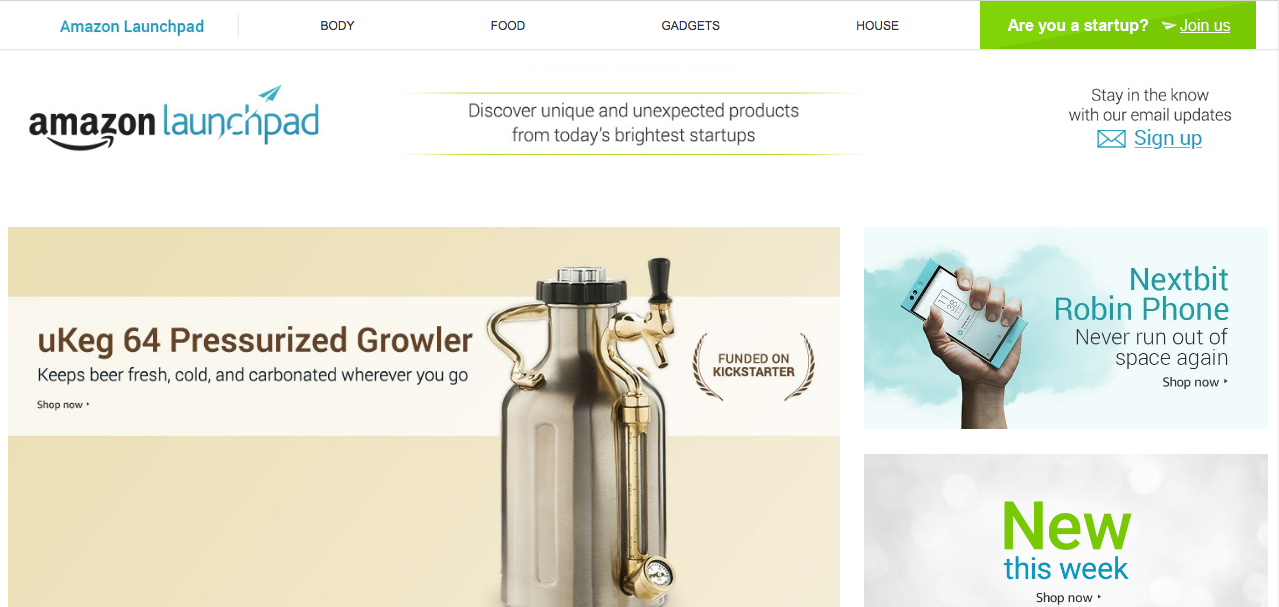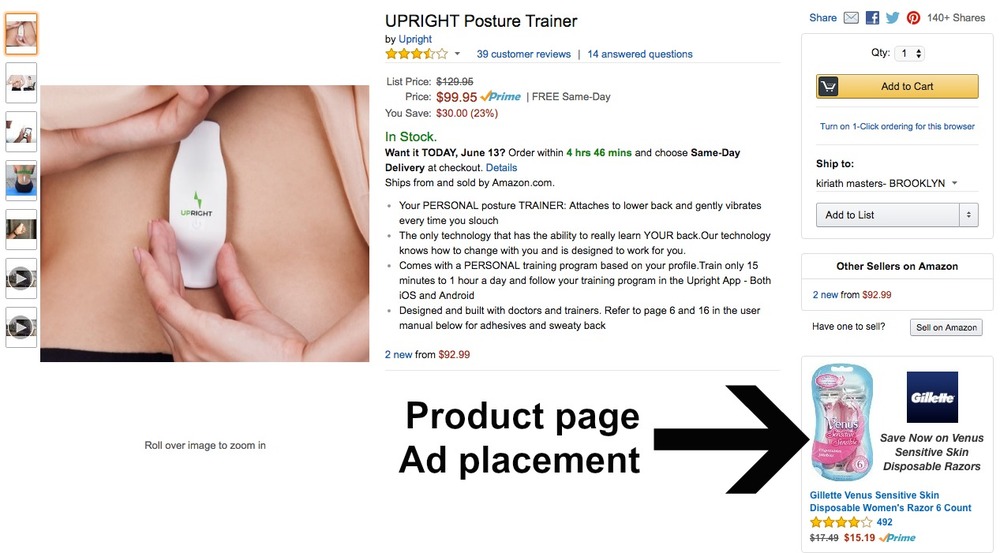Since introducing their “Launchpad” program in July 2015, Amazon has been contacting hardware startups and hot new brands with successful crowdfunding campaigns to get them onto this new program. And in May 2016, Amazon Launchpad started up in Europe, too.
It describes itself as, “Unique and unexpected products from today’s brightest startups”, with most products falling into 4 categories: Body, Food, Gadgets, and House.
There is a strong propensity toward hardware and consumer technology products - trending items like “the connected home”, and “wearable tech” are heavily represented.
As of May 2016, there are 2,163 products in the Launchpad program, which is a teeny, tiny amount compared with the estimated 400 million product listings on Amazon overall.
The Launchpad pitch sounds great to many companies who see the benefit in having their brand available to millions of customers via Amazon. But understandably, they want to know the pros and cons of the Launchpad program before committing.
Here we break down the difference between Amazon Launchpad versus Seller Central, the pros and cons of the program, and some things for brands to think about when making the decision - should we use the Amazon Launchpad program?
Amazon Launchpad Review
Marketing Benefits
The benefits of Amazon’s Launchpad program mostly center around additional marketing “juice” that they exclusively offer brands in this program. Your product(s) will get a lot more merchandising opportunities, the kind that other sellers have to pay for. These include:
- Your brand/products might be featured in their email & social media campaigns
- Ability to create a free A+ page (otherwise known as Enhanced Marketing Content) for your product(s). This allows you to create product pages with more images, even product videos which can really help with conversion. This aquaponics tank is a great example of a product page with enhanced content.
- Placement in Amazon's Launchpad store, which has a dedicated section on Amazon.com
- Access to Amazon Marketing Services (AMS) via the Vendor Express platform. AMS allows you to access different types of ad placements including headline search ads and product page placement ads. Note that you’ll be paying for these ads out of pocket.


In the gallery above:
(1) The landing page of Amazon's Launchpad "store".
(2) An example of a Product Page Placement. On this page, the Advertiser (Gillette) has a an ad placement of their Venus razor product placed on the Lumo Lift product page.
Other Benefits
-
There’s no specific time restriction on the length of the program - if your products do well, you could retain your benefits for a long time.
-
A real-life Amazon representative. Usually only the top-tier Amazon Vendors get access to an Account Executive. But Launchpad vendors are treated specially and often have access to an actual human being at Amazon who can help with special requests and onboarding.
-
Move smoothly into the regular Vendor program, if that is the direction you want to take.
-
Assistance with launching in international marketplaces. This is a benefit that Amazon states, but it’s unclear specifically what help they offer in this area beyond what they provide non-Launchpad sellers.
-
Amazon covers the cost of freight from your facility (US) to Amazon’s warehouses. This is true of the Vendor Central & Vendor Express programs in general.
Here’s the rub: there’s an application process and not everyone gets in.
THE COST & FEES OF AMAZON LAUNCHPAD
As we know, everything comes at a price, and Amazon surely doesn’t offer this great program purely from the kindness of it’s heart.
What do you pay for the privilege of all these extras?
-
You pay for it in your wholesale margin. This is typically going to be a 50% discount on the retail price of your products. And Amazon will only be paying you in 60 day terms. While wholesale “terms” are common in the world of retail, it can be tricky for new startups to handle the cash flow double-whammy that comes with lower margin and taking longer to get paid.
-
Free units to validate demand for your product. Just like in the Vendor Express program, brands need to send free units to Amazon so that they can upload them and test the market for demand. Amazon says, “We request a limited number of free units as an investment in the program. We understand that your products cost money, so we want you to know we are using them to build your Amazon.com product detail page and evaluate customer demand.”
-
You will still have to “pay to play” when promoting your products with ads. And Amazon does expect for brands to bring their own traffic. They will only place Purchase Orders (POs) for products which have demonstrated good traction with customers, which leads to...
-
Lost control over inventory & ordering. Some brands have complained of Amazon’s purchasing algorithm not meeting demand to the point that their products are out of stock on Amazon for periods. Products which are not selling in high enough volume will not be re-ordered. When managing your own product listings, you can control inventory more closely.
-
Exclusivity. Amazon might require that you only sell your product on Amazon.com and your e-commerce store, which limits your ability to sell on other marketplaces and to brick & mortar retailers.
HOW TO CHOOSE BETWEEN AMAZON LAUNCHPAD AND DOING YOUR
OWN PRODUCT LAUNCH
The alternative is Seller Central or Vendor Central. The Seller Central program is where a brand sells direct to customers, with Amazon taking a percentage referral fee - usually 15%.
You have the option to have Amazon fulfill customer orders (FBA) or do fulfillment yourself. This option often results in a better profit margin for the brand, and the brand can set the selling price to the customer. Brands also have more control over their inventory levels and are able to change most details on their product page in real-time.
However, the Brand will be responsible for more customer service activities, and some marketing tools like embedded videos and brand pages are not available to use.
DECISION MAKING FACTORS
So, how to choose between Seller Central or Vendor Express/Central (the platform that Launchpad is run from)?
Take this quiz we created:
- What is the average retail price of items in your core assortment? Your average product's retail price affects your potential margins on Amazon.
-
Are your margins wholesale-friendly? Does your brand already have a wholesale program, or would your profit margins support it? A standard wholesale discount is 50% of the retail price (RRP / MSRP).
-
How much control do you require over retail pricing? Some companies need more control over their pricing, to create a consistent experience for customers, and possibly also for wholesale relationships.
-
Are your operations wholesale-friendly? Selling to Amazon as a Vendor means that you'll need to fill large Purchase Orders (PO's) and have them sent to Amazon from a warehouse in the US.
-
How sensitive is your cash flow cycle? How frequently your company gets paid by customers can have a big impact on your company's cash flow. Vendors get paid in 60 or 90 day terms, whereas on Seller Central your payment is every 2 weeks.
-
What are your key marketing priorities? Is your company's primary focus on developing a brand, around preserving control over your product listings, or in keeping to a budget?
It’s possible to side-step the official Launchpad program and set your funded or bootstrapped product startup up on Amazon’s platform yourself. We created a free, 4-part video course that explains exactly how to launch your product on Amazon.
And if you decide to pursue the Launchpad program, we can still help! The services we offer Launchpad and Vendors on Amazon include:
- Product listing copywriting, design, and management.
- Amazon Pay Per Click (PPC) Advertising campaign management, to help generate more sales and repeat Purchase Orders from Amazon.
- Help navigating the Vendor Express system & properly utilizing all the additional benefits Amazon provides to Launchpad brands.
.png)

